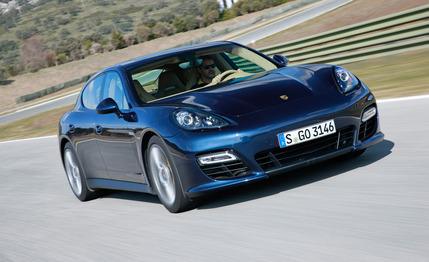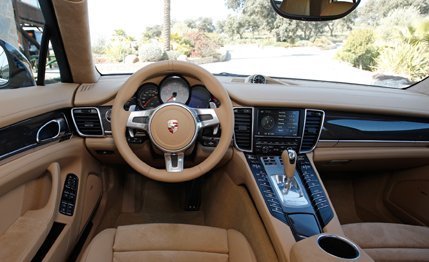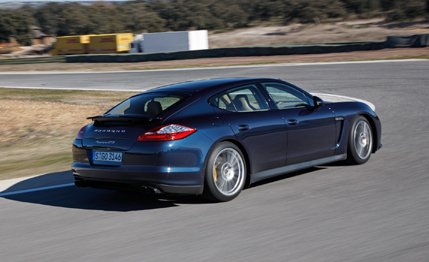 Instrumented Test
Instrumented Test

For years, Porsche has expanded its model lineups using the Taco Bell approach: same ingredients, different combinations. Take the 2013 Panamera GTS, the eighth distinct version of the big hunchback sedan. Porsche starts with a basic taco shell. Actually, the Panamera is more substantial, more of a gordita. Then the company adds all-wheel drive. Think of that as the binding unguent in the GTS’s Cheesy Gordita Crunch—a layer of mellow reassurance in a world gone mad. Now add beef, the V-8 from the S model. (The Turbo engine would be the steak; the hybrid powertrain, the health-conscious but pricey chicken.) Finish with some pepper-Jack sauce, in this case a revised intake system, cams with one millimeter of additional lift, and the stiffer valve springs from the Turbo model. The changes lift output to 430 hp from the 4S’s 400.
Other trimmings borrowed from the Panamera Turbo include its larger front brakes—the 4S already shares its rears with the Turbo—an adjustable three-piece spoiler, and 19-inch wheels. Much of the rest of the GTS equipment, including the adaptive anti-roll bars, the front fascia, and the Sport Chrono pack with its launch-control function, comes from the Panamera’s options catalog. The list of GTS-exclusive stuff is pretty short: engine upgrades, sill plates, headrest embroidery, and transmission and stability-control programming.

Tactile differences between the GTS and a similarly optioned 4S are few. The biggest change (and perhaps the best reason to choose the GTS) is the sound. Although a dual-mode sport-exhaust system is offered for the Panamera 4S, the GTS’s is more aggressive. It’s subdued in regular mode but masterfully antisocial in sport. The GTS fires up with an Italianate bark and bellows through the gears, punctuating shifts with gruff coughs and cantankerous burbles. A resonator pipes sound from the intake manifold into the A-pillars, balancing the exhaust snarl with precombustion music. After driving in sport for most of a day, we switched the exhaust to its quieter setting and immediately felt guilty, as though we’d muted Charlie Parker’s sax with a fat partridge.
Quicker shifts and appropriate engine tuning during gearchanges help to orchestrate the soundtrack. All Panameras cut fuel and ignition momentarily to smooth shifts. In the sport-plus chassis and transmission setting, the GTS cuts neither, essentially power-shifting itself. The result seems masochistic, as though the goal were to be brutal rather than quick.

The car is no doubt quick, though: We recorded a 0-to-60 run of 4.0 seconds, and the GTS covers a quarter-mile in just 12.7 seconds. Those numbers rank comfortably below the times posted by the Panamera 4S—it sits below the GTS in the Panamera food chain—but aren’t as bonkers as those of the next-level-up Panamera Turbo.
You might scoff at how similar the GTS is to the 4S, but what Porsche saved in development time, it passes on to the customer: At $110,875 to start, the GTS is thousands cheaper than a similarly optioned 4S. And a Panamera 4S is no bad thing to taste like.